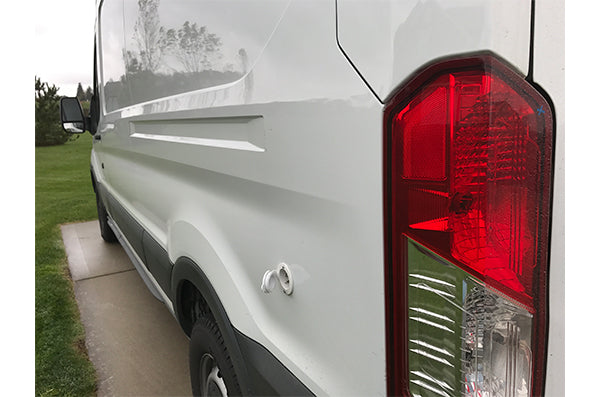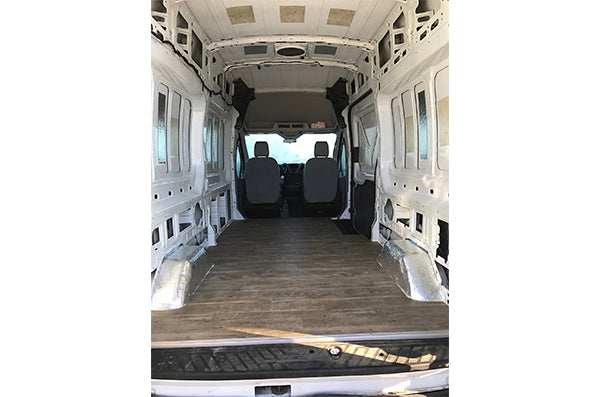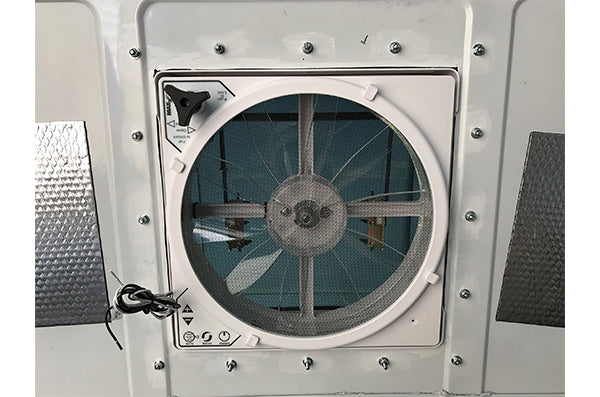The term "shore power" was new to us as we embarked on the electrical design of our Ford Transit van conversion. "Shore power" referrers to plugging into 120v AC (same power as in your house) at either a campground or your buddy's driveway. In order to take advantage of this readily available power source, you're going to need to cut another (yet much smaller) hole in your perfectly good van!
After a fair amount of research and reading of reviews, we selected the Conntek NEMA 5-15P 15 amp 125v Charger Inlet with white cover. We will only be using this power source to re-charge the house battery and charge basic electronics (phone, tablet, laptop, etc.), so 15amps is sufficient for us. If you plan on using a microwave, heater, AC or other heavy draw appliance, you'll need to research your specific amp needs and adjust accordingly. We specifically wanted the white cover to blend in with the paint of the van and not scream "RV HERE."
We chose to place the inlet on the rear drivers side of the van. We marked our spot and used blue painters tape to cover the area we wold be drilling. Using a 1.75" hole saw bit, I drilled the hole from the outside while Amanda vacuumed the metal shavings from the inside. Once the hole was complete, we removed the tape, sanded and painted the raw edge.

We installed the inlet using the two included screws, but also added a bead of silicone to the section of the inlet that would rest against the outside of the van.

The inlet is only about 4 feet from our electrical cabinet, so we opted to run 3 12 gauge THHN wires covered with split loom tubing. We terminated the wires with a 15 amp single 3 prong outlet.

We wanted to be able to access the inlet and wiring once the van build was complete, so we installed a 6" marine inspection hatch in our wood paneling.

Shore power will be a great option once our electrical system is complete, but it's also GREAT to have as a primary power source between now and then!




2 comments
Larry
Brock,
Yes, we added this “interim” shore power setup to have a power source while we figured out our longer term plan. As you can see in the electrical design post (https://seekdrygoods.com/blogs/van-life/ford-transit-van-conversion-electrical-design-install), we later ended up installing an inverter which we connected to the existing shore power connection. Overall, we used the “interim” solution a fair amount for fans, heaters, etc prior to our electrical system being installed.
Thanks
Larry
Brock,
Yes, we added this “interim” shore power setup to have a power source while we figured out our longer term plan. As you can see in the electrical design post (https://seekdrygoods.com/blogs/van-life/ford-transit-van-conversion-electrical-design-install), we later ended up installing an inverter which we connected to the existing shore power connection. Overall, we used the “interim” solution a fair amount for fans, heaters, etc prior to our electrical system being installed.
Thanks
Larry
Brock Jensen
Thanks for the write up, really helpful.
Did you just install this so that you can later add shore power? I’m on the fence about adding shore power, but my thought is that I can do something like this to power my inverter if plugged into shore power (but not charge my batteries) unless I decide to buy an inverter/charger.
Thanks for the write up, really helpful.
Did you just install this so that you can later add shore power? I’m on the fence about adding shore power, but my thought is that I can do something like this to power my inverter if plugged into shore power (but not charge my batteries) unless I decide to buy an inverter/charger.